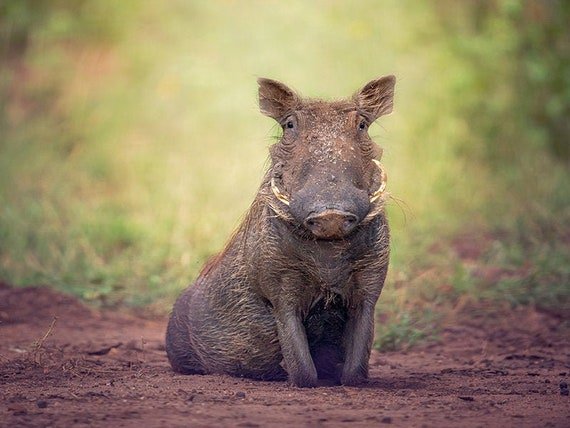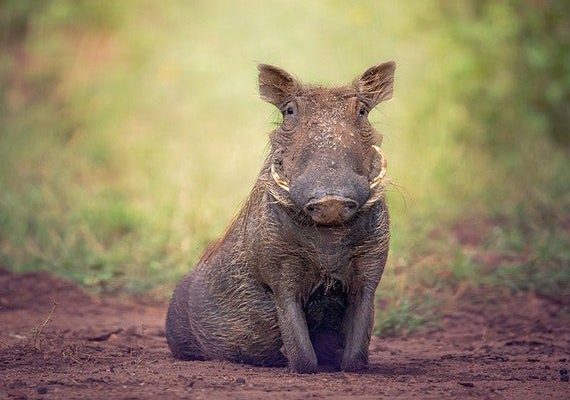
If you’ve ever found yourself wondering about animals that resemble the warthog, you’re in for a treat! Let’s dive into a few animals that look or act a bit like warthogs and explore how you can easily tell them apart. Think of it as a mini safari—right from your comfy chair.
1. Common Pig
First up on our list is the **common pig**. Pigs are known for their intelligence and social behavior. While they might not have the rugged charm of a warthog, they do share a love for mud and a penchant for rooting around in the dirt.
In terms of appearance, common pigs generally have shorter legs and rounder bodies compared to warthogs. Unlike warthogs, which have prominent tusks that curve outward, common pigs have smaller, less pronounced tusks that don’t stick out as dramatically. You might also notice that warthogs have a more elongated head, giving them a “tougher” look compared to the softer features of a common pig.
Interestingly, both species can be social, often living in groups. However, pigs are usually found in domesticated settings or farms, whereas warthogs prefer the wild. So, if you’re trying to spot a warthog, remember, they’re not hanging out in the barn!
2. Wild Boar
Next on our safari is the **wild boar**. These chunky creatures roam various parts of Europe, Asia, and North Africa. Wild boars are often mistaken for warthogs because they both have tusks and a somewhat similar body shape.
But here’s where it gets interesting: wild boars have a more pronounced coat of bristles and can appear much hairier than warthogs. Plus, wild boars typically have a stockier frame and shorter legs, which gives them a different profile altogether. When they’re young, wild boars have distinct stripes that make them look like cute little creatures, while warthogs remain generally unstriped.
Wild boars are also known to be quite territorial, unlike the more laid-back nature of warthogs. So if you encounter one, keep your distance, as they can be less friendly than their warthog counterparts.
3. Babirusa
Let’s take a detour to the **babirusa**, or “pig-deer,” which is native to Indonesia. This animal is truly unique, featuring long, upward-curving tusks that can sometimes extend beyond their snout. The babirusa may look bizarre, but it shares some common traits with the warthog, particularly in terms of body shape and herbivorous diet.
However, babirusas tend to be more slender and elegant compared to the muscular build of a warthog. Their skin is smoother and often has a lighter coloration, giving them a more delicate appearance. If you’re ever lucky enough to spot a babirusa, take a moment to appreciate the contrast between its tusks and overall body shape—it’s a sight to behold!
While warthogs are social animals often seen lounging in the sun, babirusas are more elusive and prefer dense forests. So, keep that in mind when you’re out wildlife spotting!
4. Capybara
You might be surprised to find the **capybara** on this list, but hear me out! These large rodents share the warthog’s herbivorous diet and social nature. While they don’t have tusks like warthogs, they do have a stocky body and a friendly demeanor.
Capybaras are more aquatic than warthogs, often found near water bodies. If you observe their social behavior, you’ll notice that they love to hang out in groups, much like warthogs. However, they sport a smoother coat and lack the iconic facial features of a warthog, which makes them stand out in their own right.
The big difference? Capybaras have a more laid-back lifestyle, spending a good amount of their time relaxing by rivers and lakes. If you spot one, it’s likely basking in the sun, unlike the warthog, which prefers open grasslands.
5. Peccary
Here comes the **peccary**, a pig-like animal native to the Americas. Peccaries can often be mistaken for warthogs due to their size and shape. However, they have distinct features that set them apart, such as a smaller, more compact body and a prominent, bushy crest on their backs.
One of the coolest things about peccaries is their social behavior. They often live in herds, making them quite sociable creatures. In contrast, warthogs are known to be a bit more solitary, especially males.
You might also notice that peccaries have a different diet; they tend to munch on fruits, nuts, and plants, while warthogs primarily feed on grasses and roots. So, next time you see one, remember they’re not quite the same as our warthog pals!
6. Asian Wild Boar
Not to be confused with the common wild boar, the **Asian wild boar** is a specific subspecies found in Asia. They share many similarities with the warthog, particularly in size and tusks. However, Asian wild boars generally have a more uniform coat that’s less bristly than their European cousins.
What sets them apart is their more slender head and longer legs compared to the warthog, which gives them a different silhouette. While both animals roam in social groups, Asian wild boars are known for their adaptability, thriving in various habitats from forests to grasslands.
You might also notice that the tusks of Asian wild boars are less pronounced than those of a warthog. It’s fascinating to consider how different environments shape the appearance of similar species!
7. Wart Hog’s African Cousin: The Giant Forest Hog
If you think warthogs are big, wait until you meet the **giant forest hog**! This African cousin is even larger and has a similar body shape, but it’s more elusive and prefers dense forests. They tend to have a darker coat, which can be a giveaway when trying to identify them.
Giant forest hogs also have longer legs, giving them a more graceful appearance. While warthogs are often spotted in open plains, giant forest hogs are rarely seen due to their preference for thick vegetation.
You could say they are the introverts of the hog world! If you’re lucky enough to catch a glimpse of one, you’ll definitely notice the size difference compared to the warthog.
8. Hippopotamus
It might seem like a stretch, but the **hippopotamus** and warthog do share some common ground, especially in terms of habitat and diet. Both animals thrive in African waters and feed on similar vegetation. However, hippos are much larger and have a more robust body.
While warthogs can often be found lounging in the sun, hippos spend most of their time submerged in water to keep cool. They both have tusks, but hippo tusks are far more massive and can pose a serious threat.
In terms of social structure, warthogs are generally seen in small groups, while hippos can gather in larger pods when they’re in the water. You might say they’re like distant relatives that enjoy very different lifestyles!
9. Foraging Fossa
Perhaps you didn’t expect to see a **fossa** on this list, but it’s worth mentioning! Native to Madagascar, these carnivorous creatures resemble a mix of cats and dogs but share the warthog’s love for their environment. Although they don’t share physical appearances, both are fantastic at foraging and adjusting to their habitats.
Fossas are agile and have a slender body, which contrasts with the more robust build of the warthog. They are solitary animals, often hunting alone, unlike the more social warthogs.
While fossas tend to hunt smaller prey like lemurs, warthogs focus on foraging for vegetation. It’s a quirky comparison, but it shows just how diverse the animal kingdom can be!
10. African Antelope: The Bushbuck
Finally, let’s take a look at the **bushbuck**, a medium-sized antelope that shares the African savanna with the warthog. While they’re not closely related, they share similar habitats and often nibble on the same types of vegetation.
Bushbucks have strikingly different features, with elegant bodies and long legs, setting them apart from the stocky warthog. They are also more skittish and prefer to stay hidden in thick foliage, while warthogs are more comfortable in the open.
If you spot a bushbuck, you’ll likely see it darting away, while a warthog might just give you a curious glance before going back to its foraging. Both animals have their own charm, showcasing the beauty of biodiversity in their environments.
In conclusion, these ten animals all share a bit of the warthog’s charm while showcasing their own unique traits. Whether it’s the hefty wild boar or the crafty babirusa, understanding these distinctions can enhance your appreciation for wildlife. Appreciate the similarities and differences, and you’ll find the animal kingdom is full of surprises!

